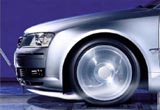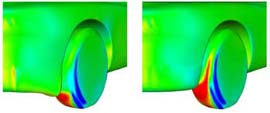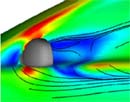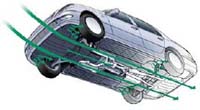|
Vehicle Design
Drag Force - Aerodynamic Design
The vehicle’s
global body shape governs the average aerodynamic performance, so it
is the most important design feature for reducing CD.
The shape should maintain attached flow over most of the surface and
can be achieved by having a streamlined shape.

The most
efficient shapes are the simple ‘teardrop’ or the airfoil based
one. Unfortunately, these shapes aren’t necessarily optimal for
overall vehicle design because they either may not gain acceptance
by consumers, or can degrade other functional aspects of a vehicle
such as trunk storage and dynamic stability.
The entire car
should have smooth shapes and sharp edges should be avoided at all
costs since they create adverse pressure gradients that produce
turbulent flow and drag. A “smooth” design can be accomplished by
creating a shape with the smallest possible curvature line, and, for
instance, having the highest possible angle between the hood and the
front windshield (rake angle). The rear of the car must be
carefully designed in concerns with drag since undesired separated
flow in this area will create a wake, thus, increase drag. An
optimal design has the separation occur as near to the end of the
vehicle as possible by incorporating a small taper as in a cutback.
Also, a reduction in the frontal area of the vehicle will greatly
reduce drag. However, reducing a vehicle’s frontal area is a very
limiting solution, since that frontal area is typically
predetermined for a vehicle program according to its size category (ie.
small car, SUV, full-size sedan, etc). Reducing it thus means
reducing the vehicle’s overall size.
 Another
source of drag is the complex flow in the wheelhouses. The airflow
in the wheelhouse and around the wheels can stand for 30 percent of
the total drag. Covering the wheelhouses may stabilize the flow in
those areas and reduce drag very significantly. However, styling
and functional issues (front turning wheels) often make it hard to
implement this solution. A compromise in design and functionality
includes integrating the shape of the wheel well with the shape of
the body. Another
source of drag is the complex flow in the wheelhouses. The airflow
in the wheelhouse and around the wheels can stand for 30 percent of
the total drag. Covering the wheelhouses may stabilize the flow in
those areas and reduce drag very significantly. However, styling
and functional issues (front turning wheels) often make it hard to
implement this solution. A compromise in design and functionality
includes integrating the shape of the wheel well with the shape of
the body.

Pressure
Distribution with and without Wheel Spoilers

Rearview
mirrors also contribute to a significant amount of a vehicle’s drag
as shown in the pressure distribution results in the flow simulation
figure to the right. Mirrors are a protrusion on the body of the
car that produces a wake behind it. By careful design, the drag of
a rearview mirror can be improved by 50% through integrating mirror
in the general shape of the car. However, the best solution for
drag reduction is without doubt, the simple replacement of the
rearview mirrors with rear cameras and onboard screens. This will
eliminate the entire drag produced by the rearview mirrors and will
provide a great improvement for the CD of the
car. However, this is not a practical solution due to high cost and
cameras and screens would add numerous processes to the
manufacturing process, not to mention that the electronics are
highly environmentally intensive to produce. Also, any fuel
efficiency gain in drag reduction would be offset by the reduction
in fuel economy from the increased electrical load.

The underbody
of a car provides a large area of improvement for the aerodynamic
drag. An optimized underbody can provide a 25% decrease in the
total drag. An exposed underbody contains uneven and cleft
structure that triggers separation and turbulence. The flow is
slowed down and the pressure gradient becomes unfavorable which
increases the pressure drag. Covering open areas with panels
reduces the turbulence and straightens the flow, thus leading to a
lower drag. Also, fitting an air dam to the front spoiler can
improve drag by reducing the airflow under the vehicle.
However,
adding underbody panels does present significant design issues that
must be considered. The added material increases overall vehicle
weight (detrimental to fuel economy) and adds manufacturing
processes requiring energy which has a negative impact on the
environment. In addition, underbody panels could pose thermodynamic
conflicts (hot underbody parts) and repair obstacles as the
suspension and driveline could become unaccessible.
|